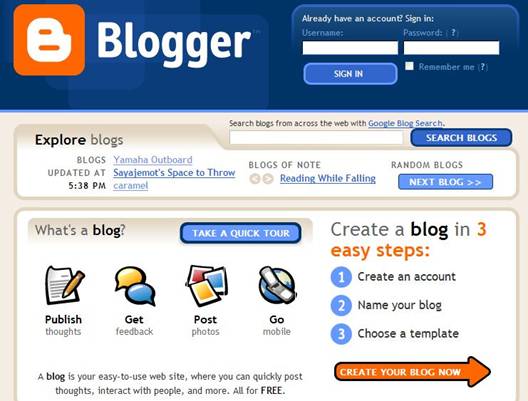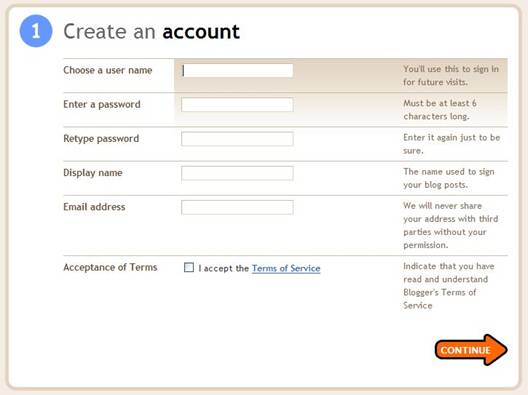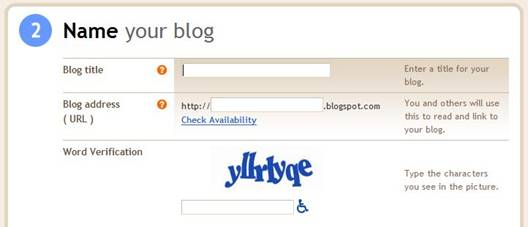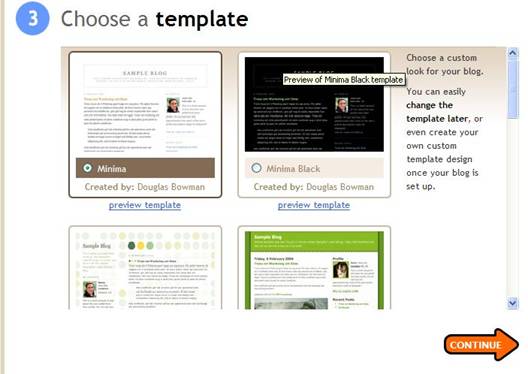Using Google’s BLOGGER
By ML Giggleman
This is the first in a series of how-to articles to introduce you to the world of blogging. If you have any questions, comments, or criticisms, please email me at mlgigg@email.hal-pc.org.
First, we’ll try to define a blog. The word Blog comes from weblog or “web log”, which is usually shortened to blog. From there, an exact definition does not seem to be easy.
Used as a noun, a blog is a type of website where entries are made, usually daily, and serves a public-accessible journal or diary. Basically, most of us will use a blog to publish our thoughts and interests, although some function as more personal online diaries. Entries are displayed in a reverse chronological order, that is, with the current date on top. Readers can then post comments, but only if you allow it.
You can post text, links, photos, video clips, sound clips, etc. A typical blog combines text, images, and links to other blogs and/or web pages, and other media related to its topic. Most blogs are mainly textual, although some focus on photographs (photoblog), videos (vlog), or audio (podcasting).
Google’s Blogger defines “blog” this way:
“In simple terms, a blog is a web site, where you write stuff on an ongoing basis. New stuff shows up at the top, so your visitors can read what’s new. Then they comment on it or email you. Or not.
Since Blogger was launched…blogs have reshaped the web, impacted politics, shaken up journalism, and enabled millions of people to have a voice and connect with others. And we’re pretty sure the whole deal is just getting started.”
The word blog, used as a verb, means to maintain or add content to a blog.
Now, what is a blogger? Blogger can refer to either the software tools used to create and publish a blog (such as Google’s Blogger.com, MSN Spaces, MySpace, Nexopia) or the person who blogs.
Pyra Labs, a service that provides Web-based tools used by individuals to publish to the Web, created the word blogger. Google now owns Pyra Labs.
Using Google’s Blogger

We are going to be dealing specifically with Google’s Blogger, which is very easy to use and, as with many bloggers, is free to use.
Getting started only takes a few minutes, and three easy steps.
Step 1. Go to the homepage for Google’s Blogger: www.blogger.com

From this page, you can do several things.
- If you already have an account, you can log in at this screen.
- You can type in a subject to “Search Blogs” for topics of interest, such as astronomy, politics, etc.
- You can check out existing blogs for ideas using “Explore blogs”, “Blogs of Note” or “Random Blog”.
- If you are a blogging newbie, you can use the Quick Tour to learn more. *** RECOMMENDED***
- Finally, when you are ready to create your own blog, click on the orange arrow in the lower right. You will be presented with the “Create An Account” page:

Information you need to complete this step:
- Account username: This is the name you use to actually sign in at Blogger.com on future visits. Many use their initials and last name. Don’t confuse this with the “Display Name”, below (#3).
- Password: Must be at least 6 characters; you must enter it two times for verification.
- Display name: This is the name that will appear when you sign blog posts, make comments, etc.
- Email address: Use a valid email address. Hint: Many people create a special account just for blogging. You have an option to publish your email address or not. Also, you can have comments to your blog sent to you via email.
Once this information is filled in, click on Acceptance of Terms of Service.
Finally, click “Continue” to go to Step 2, Name your blog.
Step 2. Name Your Blog.

Here you select a Blog Title and the Address or URL.
The Blog Title will appear at the top of your blog. Example: Kat’s Cat of the Day.
The address will be a standard URL you can use to link to your blog. It must be a unique name. There is a link below the box to check and see if your choice is already in use. Example: http://www.katscatoftheday.blogspot.com/.
It is good if it works out that you can use the same name for both, as in the example above, but they do not have to be the same.
Once you have made a selection, you must use word verification to proceed. You simply type the characters you see on screen into the box. If you make a mistake, a new series of letters will be presented for another try.
Step 3. Choose a template.

The template defines your blog’s look and feel. It can be changed later. You can scroll down the page to look at all the available templates. Under each is a “preview template” link – click and it shows a sample to give you an idea what each template looks like with information entered.
Once you select a template, click on the “Continue” arrow. You will see a final screen stating that you successfully created a blog.

Now, press the arrow to “Start Posting”, which we will cover in the next month.
Sidebar: History of the term WEBLOG and BLOG
A bit of history on the origins of the term weblog and blog: Jorn Barger coined the term “weblog” on December 17, 1997. The short form, "blog," was coined by Peter Merholz, who jokingly broke the word weblog into the phrase we blog in the sidebar of his blog Peterme.com in April or May of 1999. This was quickly adopted as both a noun and verb ("to blog," meaning "to edit one's weblog or to post to one's weblog").
For more interesting information and history of blogs, check out Wikipedia: http://en.wikipedia.org/wiki/Blog and http://en.wikipedia.org/wiki/Blogging
Sidebar: How I got into blogging
I got into blogging for only one reason: a love of cats. I found a wonderful blog, Kat’s Cat of the Day (http://www.katscatoftheday.blogspot.com/), which is for adult cats. Kat started the blog back in March 2006, after determining there were many kitten blogs and nothing for adult cats. Evidently she wasn’t the only one who wanted a blog for grown up cats. She recently won the Blogs of Summer award in the pet category by a landslide.
My cat, Missy Blue Eyes, has her own blog: http://missyblueeyes.blogspot.com/. She now has to share it with a little sister, KC, who is 5 weeks old. You can see pictures and read more about both of these remarkable cats at the blog.
In addition, we, many of the cat bloggers who meet at Kat’s site, teamed up in an effort to help homeless cats. We have a blog called “Seventh Heaven”
(http://sevenlonelykittens.blogspot.com/) which currently is spotlighting some beautiful kittens at The Houston Cat Hospital (http://www.houstoncathospital.net/index.html) and special cases both locally and out of state.
Deb Taylor has worked on some wonderful arrangements with Continental Airlines to fly the kittens and cats safely and economically to new owners anywhere in the US.
“Seventh Heaven” has been featured on Lisa Foronda’s Animal Attraction (Channel 11 News - http://www.beloblog.com/KHOU_Animal_Attraction/) and on CatCall, a Reader Blog about Cats with Laurence Simon (http://blogs.chron.com/catcall/).
M.L. Giggleman is a long-time HAL-PC member. She can be reached at mlgigg@email.hal-pc.org
|

